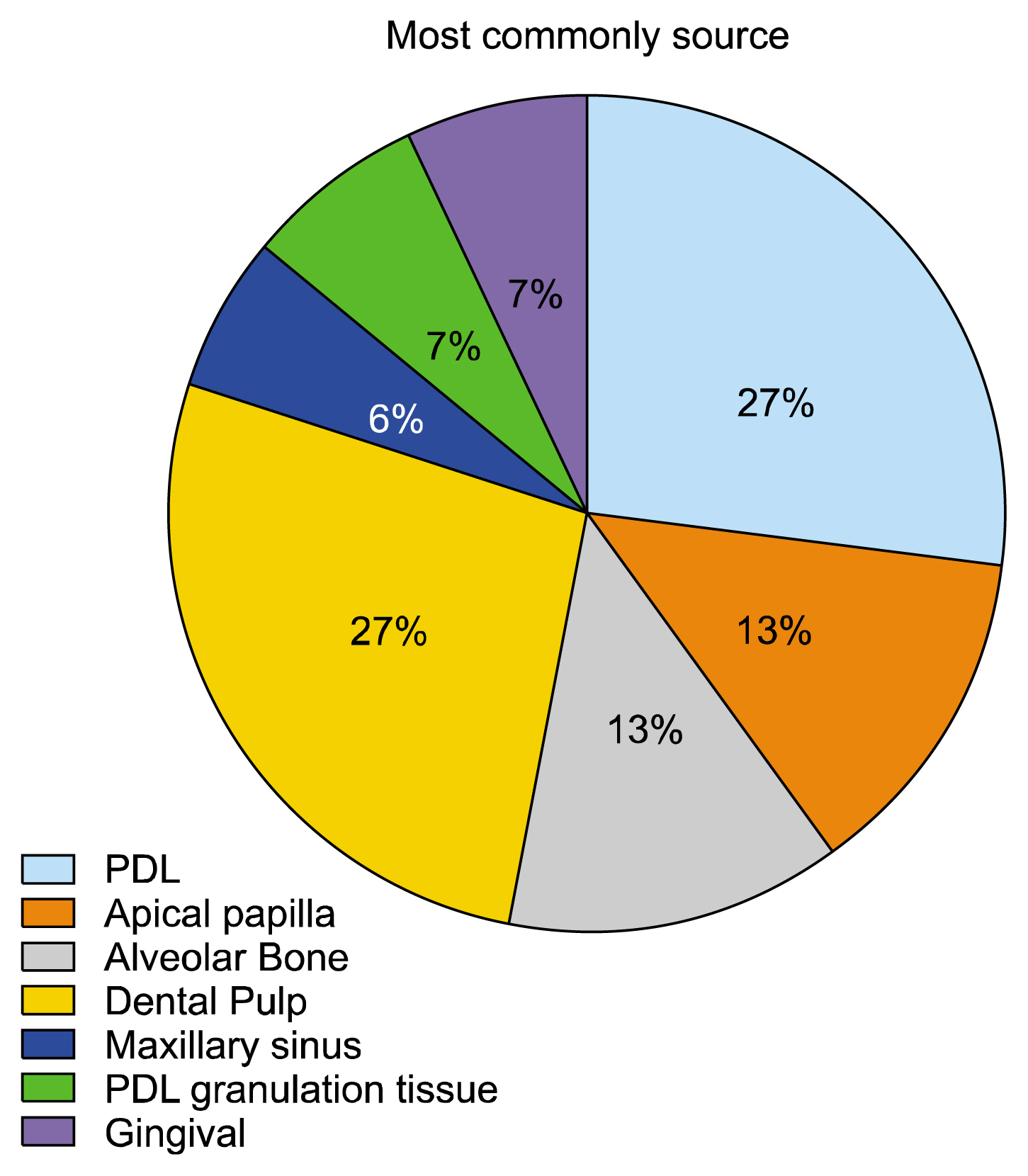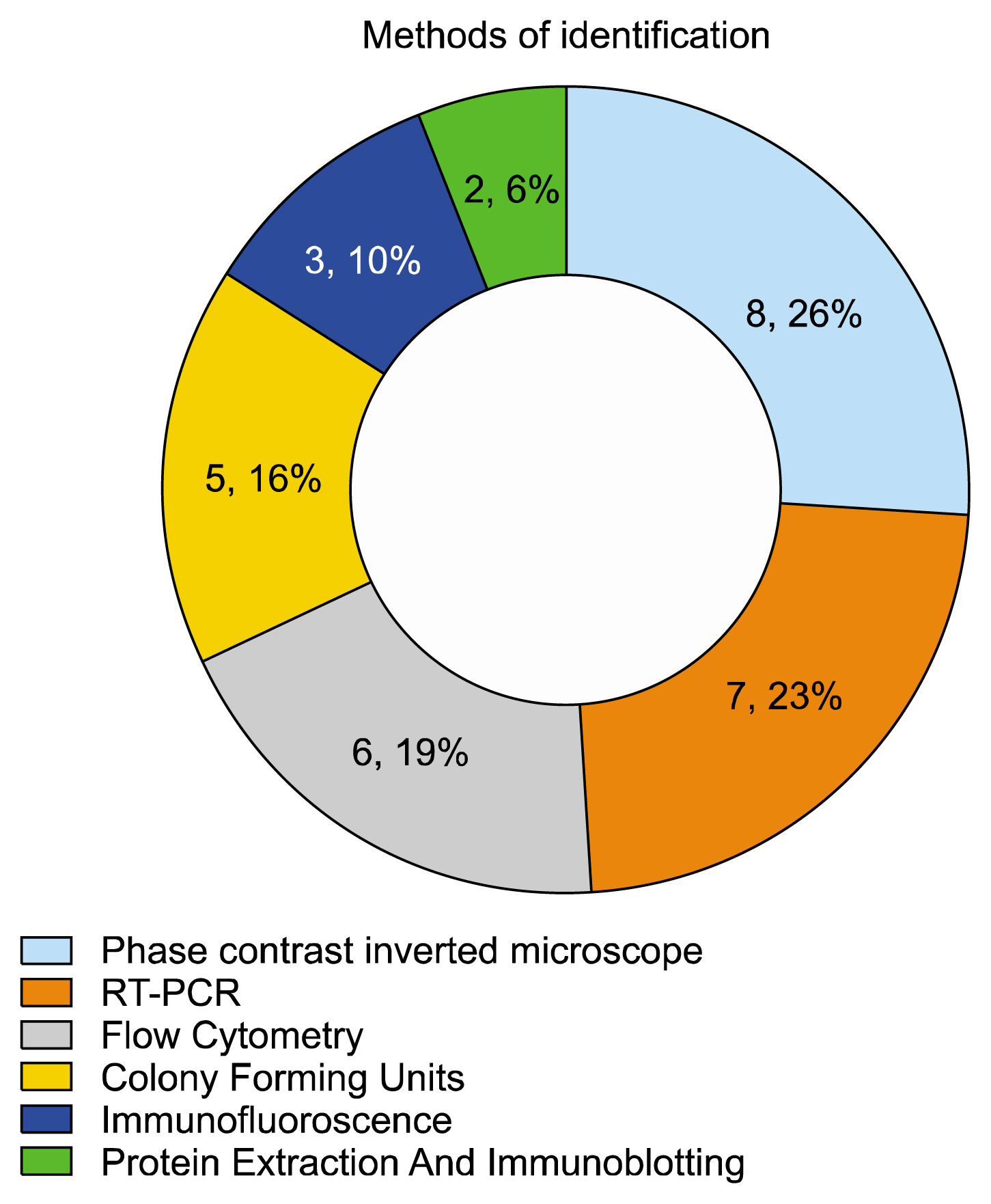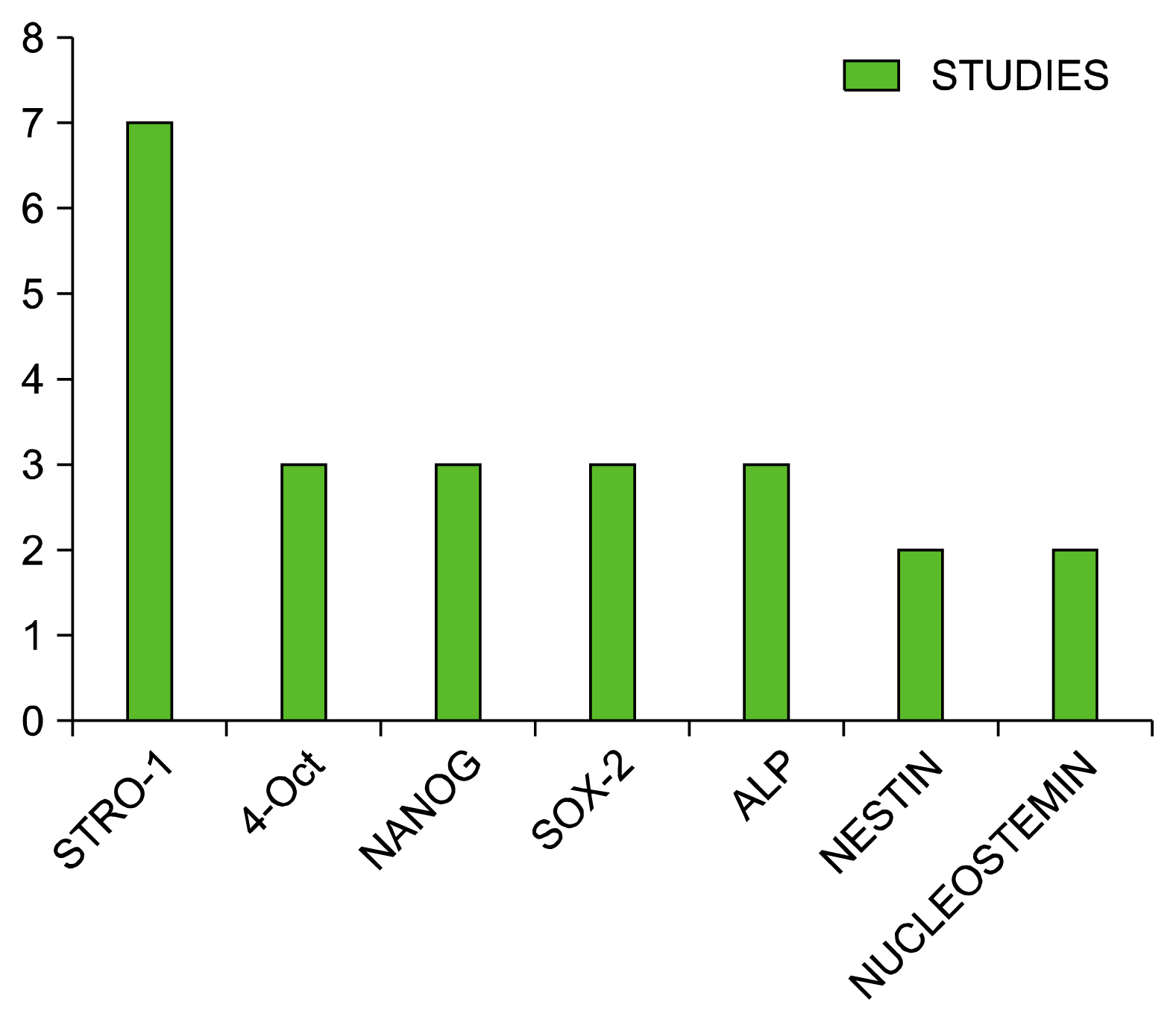Int J Stem Cells.
2017 May;10(1):12-20. 10.15283/ijsc17010.
Methods of Isolation and Characterization of Stem Cells from Different Regions of Oral Cavity Using Markers: A Systematic Review
- Affiliations
-
- 1Department of Periodontology, Saveetha Dental College, Chennai, India. avin_sourav@hotmail.com
- KMID: 2384597
- DOI: http://doi.org/10.15283/ijsc17010
Abstract
- BACKGROUND
Periodontitis is a destructive inflammatory disorder of the periodontium caused by the destruction of periodontal tissues namely the PDL, cementum, alveolar bone, and gingiva. Once these tissues are lost, the foremost goal of periodontal therapy is to regenerate the diseased tissues if possible to their original form, architecture, and function. Various regenerative procedures were employed and still a gap was found in achieving the goal. As stem cells are characterized by their ability to self-renew and differentiate to produce specialized cells, there could be a possibility of using them for regenerative therapy. Recently, dental tissues such as the PDL, the dental pulp and the tooth follicle have been recognized as readily available sources of adult stem cells. AIM: The aim was to identify the various sources and methodologies in isolation of stem cells from human oral cavity and its differentiation into various lineages using markers.
MATERIALS AND METHODS
The electronic databases PUBMED, GOOGLE SCHOLAR, SCIENCE DIRECT, COCHRANE LIBRARY along with a complimentary manual search of all periodontics journal till the year 2016. Thirteen articles were selected on the basis of the inclusion criteria. Isolation of stem cells from oral cavity through various methods has been evaluated and similarly characterization to different lineages were tabulated as variables of interest. They included human in-vitro and ex-vivo studies.
RESULTS
The results showed that PDLSC's and pulpal stem cells are the most common source from where stem cells were isolated. Each source has used different methodology in isolating the stem cells and it was found that STRO-1 was the commonly used marker in all the studies mentioned.
CONCLUSIONS
The studies showed that there is no standard protocol existed in isolating the stem cells from different sources of oral cavity. Moreover, there was no standard marker or methodology used in characterization.
Keyword
MeSH Terms
Figure
Reference
-
References
1. Haeckel E. Historie de La créacion dês etres organisés. 3rd ed. Paris: Librairie C. Reinwald;1903.2. Thomson JA, Kalishman J, Golos TG, Durning M, Harris CP, Becker RA, Hearn JP. Isolation of a primate embryonic stem cell line. Proc Natl Acad Sci U S A. 1995; 92:7844–7848. DOI: 10.1073/pnas.92.17.7844. PMID: 7544005. PMCID: 41242.
Article3. Weissman IL, Anderson DJ, Gage F. Stem and progenitor cells: origins, phenotypes, lineage commitments, and transdifferentiations. Annu Rev Cell Dev Biol. 2001; 17:387–403. DOI: 10.1146/annurev.cellbio.17.1.387. PMID: 11687494.
Article4. Smith AG. Embryo-derived stem cells: of mice and men. Annu Rev Cell Dev Biol. 2001; 17:435–462. DOI: 10.1146/annurev.cellbio.17.1.435. PMID: 11687496.
Article5. Silva LB, Neto AP, Pacheco RG, Júnior SA, de Menezes RF, Carneiro VS, Araújo NC, da Silveira MM, de Albuquerque DS, Gerbi ME, Álvares PR, de Arruda JA, Sobral AP. The Promising Applications of Stem Cells in the Oral Region: Literature Review. Open Dent J. 2016; 10:227–235. DOI: 10.2174/1874210601610010227. PMID: 27386008. PMCID: 4911749.
Article6. Jamal M, Chogle S, Goodis H, Karam SM. Dental stem cells and their potential role in regenerative medicine. J Med Sci. 2011; 4:53–61.
Article7. Mattioli-Belmonte M, Teti G, Salvatore V, Focaroli S, Orciani M, Dicarlo M, Fini M, Orsini G, Di Primio R, Falconi M. Stem cell origin differently affects bone tissue engineering strategies. Front Physiol. 2015; 6:266. DOI: 10.3389/fphys.2015.00266. PMID: 26441682. PMCID: 4585109.
Article8. Kato H, Katayama N, Taguchi Y, Tominaga K, Umeda M, Tanaka A. A synthetic oligopeptide derived from enamel matrix derivative promotes the differentiation of human periodontal ligament stem cells into osteoblast-like cells with increased mineralization. J Periodontol. 2013; 84:1476–1483. DOI: 10.1902/jop.2012.120469.
Article9. Kim SS, Kwon DW, Im I, Kim YD, Hwang DS, Holliday LS, Donatelli RE, Son WS, Jun ES. Differentiation and characteristics of undifferentiated mesenchymal stem cells originating from adult premolar periodontal ligaments. Korean J Orthod. 2012; 42:307–317. DOI: 10.4041/kjod.2012.42.6.307.
Article10. Seo BM, Miura M, Gronthos S, Bartold PM, Batouli S, Brahim J, Young M, Robey PG, Wang CY, Shi S. Investigation of multipotent postnatal stem cells from human periodontal ligament. Lancet. 2004; 364:149–155. DOI: 10.1016/S0140-6736(04)16627-0. PMID: 15246727.
Article11. Gay IC, Chen S, MacDougall M. Isolation and characterization of multipotent human periodontal ligament stem cells. Orthod Craniofac Res. 2007; 10:149–160. DOI: 10.1111/j.1601-6343.2007.00399.x. PMID: 17651131.
Article12. Karbanová J, Soukup T, Suchánek J, Pytlík R, Corbeil D, Mokrý J. Characterization of dental pulp stem cells from impacted third molars cultured in low serum-containing medium. Cells Tissues Organs. 2011; 193:344–365. DOI: 10.1159/000321160.
Article13. Yu J, He H, Tang C, Zhang G, Li Y, Wang R, Shi J, Jin Y. Differentiation potential of STRO-1+ dental pulp stem cells changes during cell passaging. BMC Cell Biol. 2010; 11:32. DOI: 10.1186/1471-2121-11-32. PMID: 20459680. PMCID: 2877667.
Article14. Laino G, d’Aquino R, Graziano A, Lanza V, Carinci F, Naro F, Pirozzi G, Papaccio G. A new population of human adult dental pulp stem cells: a useful source of living autologous fibrous bone tissue (LAB). J Bone Miner Res. 2005; 20:1394–1402. DOI: 10.1359/JBMR.050325. PMID: 16007337.
Article15. Jo YY, Lee HJ, Kook SY, Choung HW, Park JY, Chung JH, Choung YH, Kim ES, Yang HC, Choung PH. Isolation and characterization of postnatal stem cells from human dental tissues. Tissue Eng. 2007; 13:767–773. DOI: 10.1089/ten.2006.0192. PMID: 17432951.
Article16. Wu J, Huang GT, He W, Wang P, Tong Z, Jia Q, Dong L, Niu Z, Ni L. Basic fibroblast growth factor enhances stemness of human stem cells from the apical papilla. J Endod. 2012; 38:614–622. DOI: 10.1016/j.joen.2012.01.014. PMID: 22515889. PMCID: 3499972.
Article17. Fawzy El-Sayed KM, Paris S, Becker S, Kassem N, Ungefroren H, Fändrich F, Wiltfang J, Dörfer C. Isolation and characterization of multipotent postnatal stem/progenitor cells from human alveolar bone proper. J Craniomaxillofac Surg. 2012; 40:735–742. DOI: 10.1016/j.jcms.2012.01.010. PMID: 22421466.
Article18. Wada N, Wang B, Lin NH, Laslett AL, Gronthos S, Bartold PM. Induced pluripotent stem cell lines derived from human gingival fibroblasts and periodontal ligament fibroblasts. J Periodontal Res. 2011; 46:438–447. DOI: 10.1111/j.1600-0765.2011.01358.x. PMID: 21443752.
Article19. Kim SW, Lee IK, Yun KI, Kim CH, Park JU. Adult stem cells derived from human maxillary sinus membrane and their osteogenic differentiation. Int J Oral Maxillofac Implants. 2009; 24:991–998.20. Hung TY, Lin HC, Chan YJ, Yuan K. Isolating stromal stem cells from periodontal granulation tissues. Clin Oral Investig. 2012; 16:1171–1180. DOI: 10.1007/s00784-011-0600-5.
Article21. Bartold PM, McCulloch CA, Narayanan AS, Pitaru S. Tissue engineering: a new paradigm for periodontal regeneration based on molecular and cell biology. Periodontol 2000. 2000; 24:253–269. DOI: 10.1034/j.1600-0757.2000.2240113.x.
Article22. Morsczeck C, Götz W, Schierholz J, Zeilhofer F, Kühn U, Möhl C, Sippel C, Hoffmann KH. Isolation of precursor cells (PCs) from human dental follicle of wisdom teeth. Matrix Biol. 2005; 24:155–165. DOI: 10.1016/j.matbio.2004.12.004. PMID: 15890265.
Article23. Gronthos S, Arthur A, Bartold PM, Shi S. A method to isolate and culture expand human dental pulp stem cells. Methods Mol Biol. 2011; 698:107–121. DOI: 10.1007/978-1-60761-999-4_9. PMID: 21431514.
Article24. Gronthos S, Mankani M, Brahim J, Robey PG, Shi S. Postnatal human dental pulp stem cells (DPSCs) in vitro and in vivo. Proc Natl Acad Sci U S A. 2000; 97:13625–13630. DOI: 10.1073/pnas.240309797. PMID: 11087820. PMCID: 17626.25. Kaku M, Komatsu Y, Mochida Y, Yamauchi M, Mishina Y, Ko CC. Identification and characterization of neural crest-derived cells in adult periodontal ligament of mice. Arch Oral Biol. 2012; 57:1668–1675. DOI: 10.1016/j.archoralbio.2012.04.022. PMID: 22704955. PMCID: 3537832.
Article26. Gronthos S, Zannettino AC, Hay SJ, Shi S, Graves SE, Kortesidis A, Simmons PJ. Molecular and cellular characterisation of highly purified stromal stem cells derived from human bone marrow. J Cell Sci. 2003; 116:1827–1835. DOI: 10.1242/jcs.00369. PMID: 12665563.
Article27. Shi S, Bartold PM, Miura M, Seo BM, Robey PG, Gronthos S. The efficacy of mesenchymal stem cells to regenerate and repair dental structures. Orthod Craniofac Res. 2005; 8:191–199. DOI: 10.1111/j.1601-6343.2005.00331.x. PMID: 16022721.
Article28. Laino G, Graziano A, d’Aquino R, Pirozzi G, Lanza V, Valiante S, De Rosa A, Naro F, Vivarelli E, Papaccio G. An approachable human adult stem cell source for hard-tissue engineering. J Cell Physiol. 2006; 206:693–701. DOI: 10.1002/jcp.20526.
Article
- Full Text Links
- Actions
-
Cited
- CITED
-
- Close
- Share
- Similar articles
-
- Concise Review: Differentiation of Human Adult Stem Cells Into Hepatocyte-like Cells In vitro
- A Mini Overview of Isolation, Characterization and Application of Amniotic Fluid Stem Cells
- Stem cell properties of cells derived from canine periodontal ligament
- New Findings on Breast Cancer Stem Cells: A Review
- Adipose Tissue Derived Mesenchymal Stem Cells




